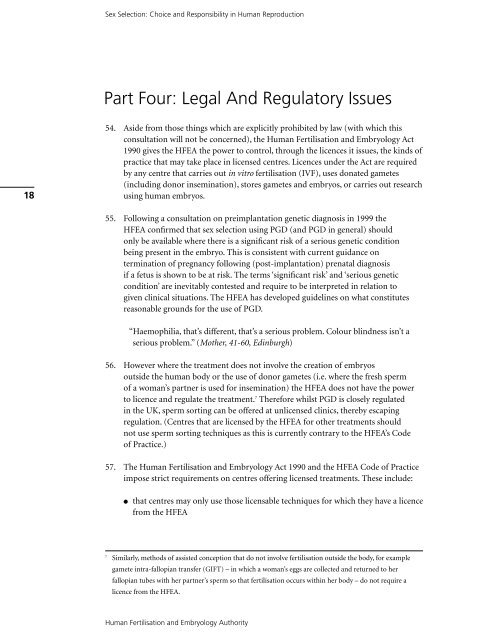Sex selection: choice and responsibility in human reproduction ...
Sex selection: choice and responsibility in human reproduction ...
Sex selection: choice and responsibility in human reproduction ...
You also want an ePaper? Increase the reach of your titles
YUMPU automatically turns print PDFs into web optimized ePapers that Google loves.
<strong>Sex</strong> Selection: Choice <strong>and</strong> Responsibility <strong>in</strong> Human ReproductionPart Four: Legal And Regulatory Issues1854. Aside from those th<strong>in</strong>gs which are explicitly prohibited by law (with which thisconsultation will not be concerned), the Human Fertilisation <strong>and</strong> Embryology Act1990 gives the HFEA the power to control, through the licences it issues, the k<strong>in</strong>ds ofpractice that may take place <strong>in</strong> licensed centres. Licences under the Act are requiredby any centre that carries out <strong>in</strong> vitro fertilisation (IVF), uses donated gametes(<strong>in</strong>clud<strong>in</strong>g donor <strong>in</strong>sem<strong>in</strong>ation), stores gametes <strong>and</strong> embryos, or carries out researchus<strong>in</strong>g <strong>human</strong> embryos.55. Follow<strong>in</strong>g a consultation on preimplantation genetic diagnosis <strong>in</strong> 1999 theHFEA confirmed that sex <strong>selection</strong> us<strong>in</strong>g PGD (<strong>and</strong> PGD <strong>in</strong> general) shouldonly be available where there is a significant risk of a serious genetic conditionbe<strong>in</strong>g present <strong>in</strong> the embryo. This is consistent with current guidance onterm<strong>in</strong>ation of pregnancy follow<strong>in</strong>g (post-implantation) prenatal diagnosisif a fetus is shown to be at risk. The terms ‘significant risk’ <strong>and</strong> ‘serious geneticcondition’ are <strong>in</strong>evitably contested <strong>and</strong> require to be <strong>in</strong>terpreted <strong>in</strong> relation togiven cl<strong>in</strong>ical situations. The HFEA has developed guidel<strong>in</strong>es on what constitutesreasonable grounds for the use of PGD.“Haemophilia, that’s different, that’s a serious problem. Colour bl<strong>in</strong>dness isn’t aserious problem.” (Mother, 41-60, Ed<strong>in</strong>burgh)56. However where the treatment does not <strong>in</strong>volve the creation of embryosoutside the <strong>human</strong> body or the use of donor gametes (i.e. where the fresh spermof a woman’s partner is used for <strong>in</strong>sem<strong>in</strong>ation) the HFEA does not have the powerto licence <strong>and</strong> regulate the treatment. 7 Therefore whilst PGD is closely regulated<strong>in</strong> the UK, sperm sort<strong>in</strong>g can be offered at unlicensed cl<strong>in</strong>ics, thereby escap<strong>in</strong>gregulation. (Centres that are licensed by the HFEA for other treatments shouldnot use sperm sort<strong>in</strong>g techniques as this is currently contrary to the HFEA’s Codeof Practice.)57. The Human Fertilisation <strong>and</strong> Embryology Act 1990 <strong>and</strong> the HFEA Code of Practiceimpose strict requirements on centres offer<strong>in</strong>g licensed treatments. These <strong>in</strong>clude:●that centres may only use those licensable techniques for which they have a licencefrom the HFEA7Similarly, methods of assisted conception that do not <strong>in</strong>volve fertilisation outside the body, for examplegamete <strong>in</strong>tra-fallopian transfer (GIFT) – <strong>in</strong> which a woman’s eggs are collected <strong>and</strong> returned to herfallopian tubes with her partner’s sperm so that fertilisation occurs with<strong>in</strong> her body – do not require alicence from the HFEA.Human Fertilisation <strong>and</strong> Embryology Authority
















